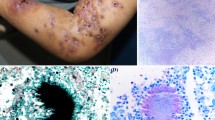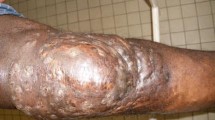Abstract
Mycetoma is a chronic granulomatous infection that is present worldwide and endemic in tropical and subtropical regions. The infection is caused by the traumatic inoculation of a fungus (eumycetoma) or a bacterium (actinomycetoma) and generally remains localized, causing cutaneous and subcutaneous tissue swelling, nodule formation, and drainage through sinus tracts. This review details the history of mycetoma, which may date as far back as the Byzantine period (300–600 AD), the epidemiology of the disease, which is characterized by an endemic region located between the latitudes of 15° south and 30° north, and the clinical presentation and treatment of mycetoma, focusing on the differences between eumycete and actinomycete infections. Diagnosis is established by identifying the type of grains found in the discharge, which guides treatment. Mycetoma caused by bacteria can usually be managed effectively with antibacterial medication alone, while infections with fungi require antifungal medication and surgery. Without proper treatment, mycetoma can lead to deformity, amputation, and death.





Similar content being viewed by others
References
Ahmed AO, van Leeuwen W, Fahal A, et al. Mycetoma caused by Madurella mycetomatis: a neglected infectious burden. Lancet Infect Dis. 2004 Sep; 4 (9): 566–74
Hay RJ. Deep fungal infections. In: Freedberg IM, Eisen AZ, Wolff K, et al., editors. Fitzpatrick’s dermatology in general medicine. 5th edition. Vol. 2. New York: McGraw-Hill; 1999: 2372–7
McGinnis MR. Mycetoma. Dermatol Clin. 1996 Jan; 14 (1): 97–104
Fahal AH. Mycetoma: a thorn in the flesh. Trans R Soc Trop Med Hyg. 2004 Jan; 98 (1): 3–11
Hershkovitz I, Speirs M, Katznelson A, et al. Unusual pathological condition in the lower extremities of a skeleton from ancient Israel. Am J Phys Anthropol. 1992 May; 88 (1): 23–6
Kwon-Chung KJ, Bennett JE. Mycetoma. In: Cann C, editor. Medical mycology. Malvern (PA): Lea & Febiger; 1992: 560–93
Corre A. La maladie de Ballingall (pied du Maduré). Arch Med Nav. 1883; 39 (81): 204–24
Godfrey J. Diseases of the foot not hitherto described. Lancet. 1846; 1: 593–4
Carter HV. On a new striking form of fungus disease principally affecting the foot and prevailing endemically in many parts of India. Trans Med Phys Soc Bombay. 1860; 60: 140–2
Pinoy E. Actinomycoses and mycetomas. Bull Inst Past. 1913; 11: 929–38
Fahal AH. Review article [online]. Khartoum: Mycetoma Research Center, 2000. Available from URL: http://www.myeetoma.org/updates.htm [Accessed 2006 Sep 12]
Green WO, Adams TE. Mycetoma in the United States. Am J Clin Path. 1964 Jul; 42: 75–91
Tight RR, Bartlett MS. Actinomycetoma in the United States. Rev Infect Dis. 1981 Nov–Dec; 3 (6): 1139–50
Foltz KD, Fallat LM. Madura foot: atypical finding and case presentation. J Foot Ankle Surg. 2004 Sep–Oct; 43 (5): 327–31
Rigopoulos D, Mavridou M, Nicolaidou E, et al. Mycetoma due to actinomycetes: a rare entity in Europe. Int J Dermatol. 2000 Jul; 39 (7): 557–8
De Palma L, Marinelli M, Pavan M, et al. A rare European case of Madura foot due to actinomycetes. Joint Bone Spine. 2006 May; 73 (3): 321
Lupi O, Tyring SK, McGinnis MR. Tropical dermatology: fungal tropical diseases. J Am Acad Dermatol. 2005 Dec; 53 (6): 931–51
Maiti PK, Ray A, Bandyopadhyay S. Epidemiological aspects of mycetoma from a retrospective study of 264 cases in West Bengal. Trop Med Int Health. 2002 Sep; 7 (9): 788–92
Welsh O, Vera-Cabrera L, Salinas-Carmona MC. Mycetoma [online]. New York: eMedicine.com, 2005. Available from URL: http://www.emedicine.com/derm/topic280.htm [Accessed 2006 Sep 12]
Khatri ML, Al-Halali HM, Fouad Khalid M. Mycetoma in Yemen: clinicoepidemiologic and histopathologic study. Int J Dermatol. 2002 Sep; 41 (9): 586–93
Abbott P. Mycetoma in the Sudan. Trans R Soc Trop Med Hyg. 1956 Jan; 50 (1): 11–30
Pang KR, Wu JJ, Huang DB. Subcutaneous fungal infections. Dermatol Ther. 2004; 17 (6): 523–31
Sobera JO, Elewski BE. Mycetoma. In: Bolognia JL, Jorizzo JL, Rapini RP, et al., editors. Dermatology. Vol. 1. New York: Mosby, 2003: 1187–8
Verdolini R, Amerio P, Bugatti L, et al. Madura’s foot: report of a case caused by Madurella mycetomatis. Fur J Dermatol. 2000 Dec; 10 (8): 627–9
Turner PG. Madura foot or plantar fibromatosis. J Bone Joint Surg Br. 1989 May; 71 (3): 531
Fahal AH, et Hassan AM, Abdelalla AO, et al. Cystic mycetoma: an unusual clinical presentation of Madurella mycetomatis infection. Trans R Soc Trop Med Hyg. 1998 Jan–Feb; 92 (1): 66–7
Richardson MD, Warnock DW. Mycetoma. In: Richardson MD, Warnock DW. Fungal infection diagnosis and management. 2nd ed. Malden (MA): Blackwell Science, Inc., 1997: 204–9
Boiron P, Locci R, Goodfellow M, et al. Nocardia, nocardiosis and mycetoma. Med Mycol. 1998; 36 Suppl. 1: 26–37
Fahal AH. Evidence based guidelines for mycetoma patients’ management [online]. Khartoum: Mycetoma Research Center, 2000. Available from URL: http://www.myeetoma.org/updatesmanagment.htm [Accessed 2006 Sep 12]
Abd Bagi ME, Fahal AH, Sheik HE, et al. Pathological fractures in mycetoma. Trans R Soc Trop Med Hyg. 2003 Sep–Oct; 97 (5): 582–4
Sharif HS, Clark DC, Aabed MY, et al. Mycetoma: comparison of MR imaging with CT. Radiology. 1991 Mar; 178 (3): 865–70
Czechowski J, Nork H, Haas D, et al. MR and other imaging methods in the investigation of mycetomas. Acta Radiol. 2001 Jan; 42 (1): 24–6
Yera H, Bougnox ME, Jeanrot C, et al. Mycetoma of the foot caused by Fusarium solani: identification of the etiologic agent by DNA sequencing. J Clin Microbiol. 2003 Apr; 41 (4): 1805–8
Ahmed A, Adelmann D, Fahal A, et al. Environmental occurrence of Madurella mycetomatis, the major agent of human eumycetoma in Sudan. J Clin Microbiol. 2002 Mar; 40 (3): 1031–6
Mahgoub ES, Gumaa SA. Ketoconazole in the treatment of eumycetoma due to Madurella mycetoma. Trans R Soc Trop Med Hyg. 1984; 78 (3): 376–9
Aiyenuro O, Nathan S. Mycetoma presenting as a painful ankle monoarthropathy: a case report. Foot Ankle Surg. 2006; 12: 43–6
Mahgoub ES. Medical management of mycetoma. Bull World Health Organ. 1976; 54 (3): 303–10
Welsh O, Sauceda E, Gonzalez J, et al. Amikacin alone and in combination with trimethoprim-sulfamethoxazole in the treatment of actinomycotic mycetoma. J Am Acad Dermatol. 1987 Sep; 17 (3): 443–8
Kashima M, Kano R, Mikami Y, et al. A successfully treated case of mycetoma due to Nocardia veterana. Br J Dermatol. 2005 Jun; 152 (6): 1349–52
Sharma N, Mendiratta V, Sharma RC, et al..Pulse therapy with amikacin and dapsone for the treatment of actinomycotic foot: a case report. J Dermatol. 2003 Oct; 30 (10): 742–7
Fuentes A, Arenas R, Reyes M, et al..Actinomycetoma and Nocardia sp.: report of five cases treated with imipenem or imipenem plus amikacin [in Spanish]. Gac Med Mex. 2006 May–Jun; 142 (3): 247–52
Gomez A, Saul A, Bonifaz A, et al..Amoxicillin and clavulanic acid in the treatment of actinomycetes. Int J Dermatol. 1993 Mar; 32 (3): 218–20
Ramam M, Garg T, D’Souza P, et al..A two-step schedule for the treatment of actinomycotic mycetomas. Acta Derm Venereol. 2000 Sep–Oct; 80 (5): 378–80
Acknowledgments
The authors have no conflict of interests financially or otherwise with any subject matter discussed in this review. No sources of funding were used in the preparation of this review.
Author information
Authors and Affiliations
Corresponding author
Rights and permissions
About this article
Cite this article
Lichon, V., Khachemoune, A. Mycetoma. Am J Clin Dermatol 7, 315–321 (2006). https://doi.org/10.2165/00128071-200607050-00005
Published:
Issue Date:
DOI: https://doi.org/10.2165/00128071-200607050-00005




